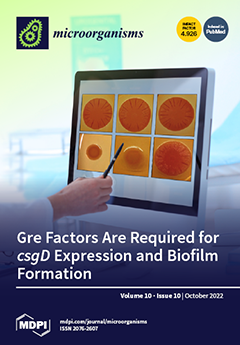Lactobacillus spp. generally dominate the vaginal microbiota and prevent pathogen adhesion and overgrowth, including
Candida spp., by various mechanisms. Although
Candida spp. can be commensal, in certain conditions they can become pathogenic, causing vulvovaginal candidiasis. The insurgence of candidiasis is related to the
[...] Read more.
Lactobacillus spp. generally dominate the vaginal microbiota and prevent pathogen adhesion and overgrowth, including
Candida spp., by various mechanisms. Although
Candida spp. can be commensal, in certain conditions they can become pathogenic, causing vulvovaginal candidiasis. The insurgence of candidiasis is related to the expression of
Candida virulence factors, including morphologic switching and biofilm formation. Germ tubes, pseudohyphae, and hyphae promote
Candida tissue invasion, biofilms increase persistence and are often resistant to antifungals and host immune response. Here, we explored the inhibitory activity of vaginal
Lactobacillus strains belonging to
Lactobacillus crispatus,
Lactobacillus gasseri,
Limosilactobacillus vaginalis, and
Lactiplantibacillus plantarum species towards
Candida virulence factors. With the aim to investigate the interrelation between mode of growth and functionality, supernatants were collected from lactobacilli planktonic cultures and, for the first time, from adherent ones, and were evaluated towards
Candida dimorphic switching and biofilm.
Candida biofilms were analyzed by multiple methodologies, i.e., crystal violet staining, MTT assay, and confocal microscopy.
Lactobacillus supernatants reduce
Candida switching and biofilm formation. Importantly,
L. crispatus supernatants showed the best profile of virulence suppression, especially when grown in adherence. These results highlight the role of such species as a hallmark of vaginal eubiosis and prompt its employment in new probiotics for women’s health.
Full article






